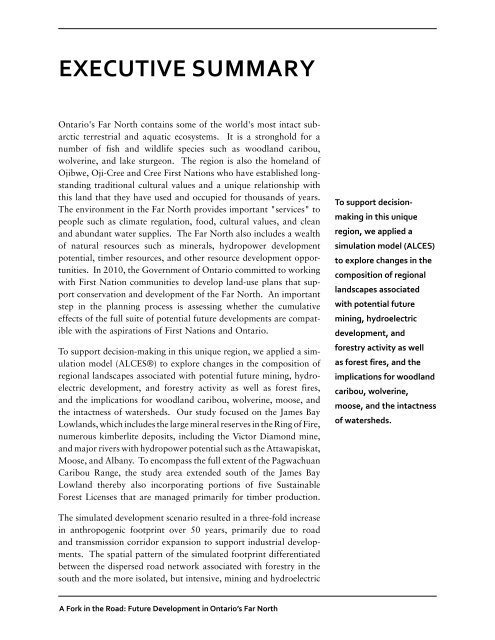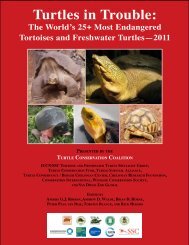You also want an ePaper? Increase the reach of your titles
YUMPU automatically turns print PDFs into web optimized ePapers that Google loves.
Executive Summary<br />
Ontario's Far North contains some of the world's most intact subarctic<br />
terrestrial and aquatic ecosystems. It is a stronghold for a<br />
number of fish and wildlife species such as woodland caribou,<br />
wolverine, and lake sturgeon. The region is also the homeland of<br />
Ojibwe, Oji-Cree and Cree First Nations who have established longstanding<br />
traditional cultural values and a unique relationship with<br />
this land that they have used and occupied for thousands of years.<br />
The environment in the Far North provides important "services" to<br />
people such as climate regulation, food, cultural values, and clean<br />
and abundant water supplies. The Far North also includes a wealth<br />
of natural resources such as minerals, hydropower development<br />
potential, timber resources, and other resource development opportunities.<br />
In 2010, the Government of Ontario committed to working<br />
with First Nation communities to develop land-use plans that support<br />
conservation and development of the Far North. An important<br />
step in the planning process is assessing whether the cumulative<br />
effects of the <strong>full</strong> suite of potential future developments are compatible<br />
with the aspirations of First Nations and Ontario.<br />
To support decision-making in this unique region, we applied a simulation<br />
model (ALCES®) to explore changes in the composition of<br />
regional landscapes associated with potential future mining, hydroelectric<br />
development, and forestry activity as well as forest fires,<br />
and the implications for woodland caribou, wolverine, moose, and<br />
the intactness of watersheds. Our study focused on the James Bay<br />
Lowlands, which includes the large mineral reserves in the Ring of Fire,<br />
numerous kimberlite deposits, including the Victor Diamond mine,<br />
and major rivers with hydropower potential such as the Attawapiskat,<br />
Moose, and Albany. To encompass the <strong>full</strong> extent of the Pagwachuan<br />
Caribou Range, the study area extended south of the James Bay<br />
Lowland thereby also incorporating portions of five Sustainable<br />
Forest Licenses that are managed primarily for timber production.<br />
To support decisionmaking<br />
in this unique<br />
region, we applied a<br />
simulation model (ALCES)<br />
to explore changes in the<br />
composition of regional<br />
landscapes associated<br />
with potential future<br />
mining, hydroelectric<br />
development, and<br />
forestry activity as well<br />
as forest fires, and the<br />
implications for woodland<br />
caribou, wolverine,<br />
moose, and the intactness<br />
of watersheds.<br />
The simulated development scenario resulted in a three-fold increase<br />
in anthropogenic footprint over 50 years, primarily due to road<br />
and transmission corridor expansion to support industrial developments.<br />
The spatial pattern of the simulated footprint differentiated<br />
between the dispersed road network associated with forestry in the<br />
south and the more isolated, but intensive, mining and hydroelectric<br />
A Fork in the Road: Future Development in Ontario’s Far North<br />
v







![RaLand / SeaScape [PDF] - Wildlife Conservation Society](https://img.yumpu.com/49974326/1/190x245/raland-seascape-pdf-wildlife-conservation-society.jpg?quality=85)









